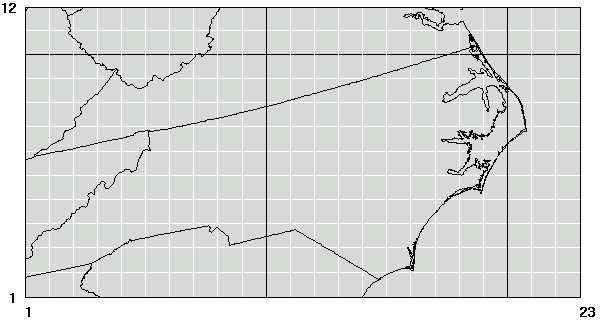The nctox case provides users with an example of using both criteria and toxics emissions inventories. The purposes of this case include:
-
Providing a test case for SMOKE on users computers
-
Provide example scripts that users may adapt to their own cases
This case has the following major features. It runs for July 9th and 10th, 1996 on a 36-km Lambert Conformal grid over North Carolina. The spatial extent of this case has been limited to provide a relatively fast test case. The case includes toxics processing for stationary area, nonroad mobile, on-road mobile, and point sources.
At this time, the case uses North Carolina records only from the following inventory data:
stationary area sources: 1996 NEI version 3.11 for CO, NOx, VOC, SO2, NH3, PM10, and PM2.5; 1999 NEI version 3 draft for toxics inventory
nonroad mobile sources: 1996 NEI version 3.11 for CO, NOx, VOC, SO2, NH3, PM10, and PM2.5; 1999 NEI version 3 draft for toxics inventory
on-road mobile sources: 1999 VMT (version 2 criteria) and speed for all pollutants
point sources: 1996 NEI version 3.11 for CO, NOx, VOC, SO2, NH3, PM10, and PM2.5; 1999 NEI version 3 draft for toxics inventory
biogenic sources: BELD2 data running using BEIS2 (for entire grid, even those cells that are not in North Carolina)
For area, mobile, and point sources, this case uses toxics inventories for ozone modeling. The VOC model species for the current CB4 mechanism are based in part on the toxic inventory. SMOKE resolves the duplicate VOC mass caused by combining VOC emissions with toxic VOC emissions by subtracting the toxic VOC mass from the VOC mass and computing a NONHAPVOC emissions value. This is the “integrate” approach for VOC emissions, described in Section 2.9.5, “Combine toxics and criteria inventories”. The speciation profiles provided with this version of SMOKE include profiles that map the toxics VOC and NONHAPVOC pollutants to current CB4 species. Choices for speciation profiles in this version of SMOKE are listed in Section 4.5.10, “Use a different speciation mechanism or change speciation inputs”.
In addition to the inventory data listed above, the parameters of the case are the following:
-
Episode: July 9th and 10th of 1996
-
Output time zone: Greenwich Mean Time (zone 0)
-
Projection: Lambert Conformal with Alpha=30, Beta=60, Gamma=-100, and center at (-100,40)
-
Domain: Origin at (-1404, -432) kilometers with 23 columns by 12 rows and 36-km square grid cells (shown in Figure 4.1, “nctox domain”)
-
Meteorology data: Daily (25-hour) 1996 meteorology files in MCIP output format generated originally by EPA using MM5 and MCIP, a total of 2 files for in July for the national domain used in the 1996 NEI case.
-
Chemical speciation data: Revised GSPRO and GSREF files to include toxic pollutants mapped to current-CB4 mechanism for both on-road and nonroad mobile source classification category (SCC) codes.
-
MOBILE6 inputs (on-road only): A single MOBILE6 scenario is used for this case for all counties in NC (though this is not the standard configuration, it runs faster for use as an installation test case).
-
Meteorology handling for on-road MOBILE6 setup:
-
Spatial: The average 24-hour temperature and humidity profile run in MOBILE6 is averaged over all counties in NC. This is not the most detailed approach available in SMOKE, but it helps the case run faster.
-
Temporal: The average 24-hour temperature and humidity profile run in MOBILE6 is averaged over both days in the episode.
-
-
Other input files: Refer to the list of default files provided in Section 8.1.4, “Input files for SMOKE nctox case” for this case.
